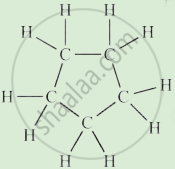Advertisements
Advertisements
प्रश्न
What is the difference between a polar covalent compound and a non-polar covalent compound?
उत्तर
Polar Covalent Compound:
- Atoms have unequal distribution of their shared pair of electrons.
- The unequal distribution of electrons draws the electron pair to the more electronegative atom.
- Polar covalent molecules are asymmetrical and not electrically neutral. Separation of charges occurs. The atom that attracts electrons more strongly has a slightly negative charge, while the other atom is slightly positive.
Non-polar covalent compound:
- Atoms have equal distribution of shared electron pairs.
- Atoms attract each other with equal force due to the equal distribution of electrons.
- Non-polar covalent molecules are symmetric and electrically neutral. There is no charge separation within the molecule.
APPEARS IN
संबंधित प्रश्न
State the reason to explain why covalent compounds "are bad conductors of electricity".
Ethane, with the molecular formula C2H6 has ______.
Name one covalent compound containing chlorine.
Elements forming ionic compounds attain noble gas electronic configuration by either gaining or losing electrons from their valence shells. Explain giving reason why carbon cannot attain such a configuration in this manner to form its compounds. Name the type of bonds formed in ionic compounds and in the compounds formed by carbon. Also explain the reason why carbon compounds are generally poor conductors of electricity.
The covalent bond in which the electrons are shared equally between the combining atoms.
Explain the following briefly:
Sodium chloride dissolves in water but carbon tetra chloride is insoluble in water.
Element A has 2 electrons in its M shell. Element B has atomic number 7.
If the compound formed between A and B is melted and an electric current is passed through the molten compound, the element A will be obtained at the ______ and B at the ______ of the electrolytic cell.
Answer the following question.
What is methane? Draw its electron dot structure. Name the type of bonds formed in this compound. Why are such compounds:
(i) poor conductors of electricity? and
(ii) have low melting and boiling points? What happens when this compound burns in oxygen?
Name the types of Hydrocarbons.
Complete the following activity.
Write the names of the hydrocarbons for the following structural formula.
(isobutylene, cyclohexane, propene, cyclohexene, cyclopentane, benzene, propyne, isobutane, propane)
 |
